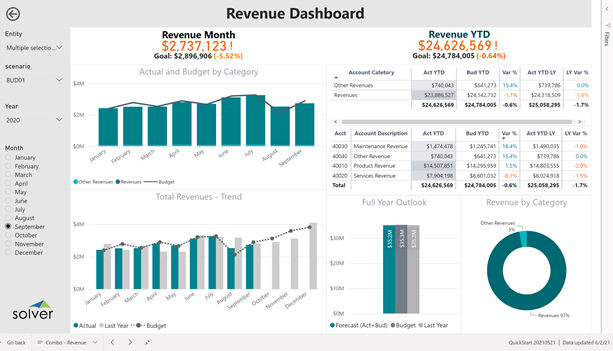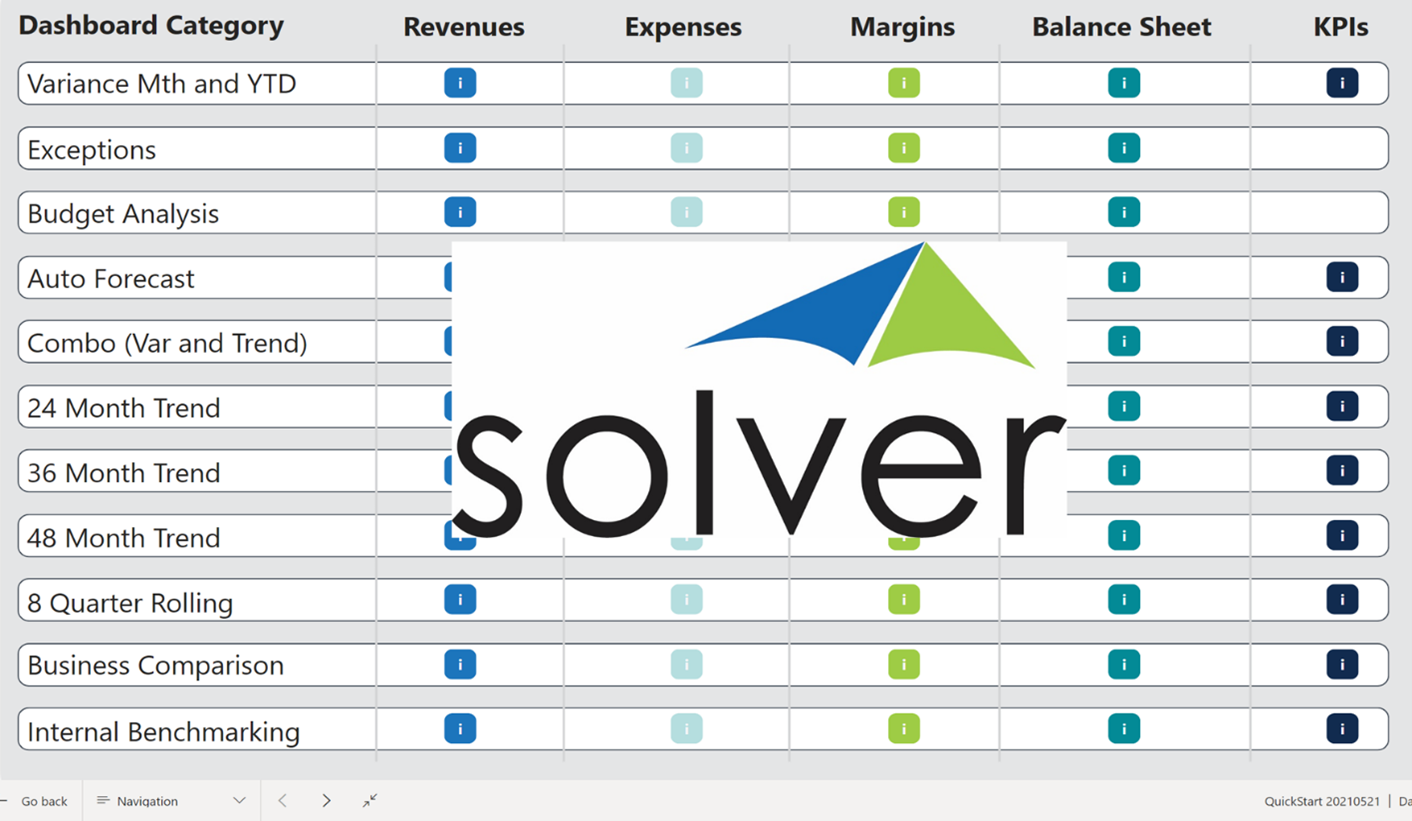How to Quickly Deploy Power BI Dashboards for Dynamics 365 Business Central
Microsoft Dynamics 365 Business Central (D365 BC) and Power BI are both rapidly growing cloud solutions. Although these solutions can be used separately, they are very often used together as an integrated platform. As executives drive their accounting teams to migrate to a modern cloud ERP system like D365 BC, senior leaders are, at the same time, hoping and expecting to gain world-class analysis with their new ERP. For that reason, evaluation teams not only have to review core ERP functionality to make sure their current and future needs are met, but they also must review which tools to use for dashboards, reporting, and planning. Power BI is the natural data visualization dashboard choice for Dynamics 365 ERP customers. It comes both as an embedded option inside D365 BC and, with a full license, it can be used as a stand-alone web service that includes all kinds of other data as well. As with all flexible dashboard software, however, it can be complex, time-consuming and costly to develop Power BI report models with numerous dashboards and then tailor them to your business dimensions, including your chart of accounts. This blog will focus on rapid deployment of Power BI dashboards for Dynamic 365 Business Central data, as well as several factors you may want to think about to ensure your executive’s expectations are met or exceeded when it comes to providing them with:
 Many D365 BC customers support a user’s graphical analysis needs through Excel because the software is already owned, users already know how to use it, and the interface is easy and flexible to build while maintaining the underlying formulas. However, there is a rapidly growing demand for cloud-based, best-of-breed dashboard tools like Power BI that offer a dynamic and secure user experience with rich, interactive charting and drill-down that provides a real-time and self-service
reporting and analysis process.
How to Pick the Right Dashboard Solution for Dynamics 365 Business Central Much can be written about the best and most affordable way to deploy Power BI. Most organizations find that delivering a rich and sustainable dashboard experience to their business and office of finance users requires more than just a Power BI license. These other components include:
Many D365 BC customers support a user’s graphical analysis needs through Excel because the software is already owned, users already know how to use it, and the interface is easy and flexible to build while maintaining the underlying formulas. However, there is a rapidly growing demand for cloud-based, best-of-breed dashboard tools like Power BI that offer a dynamic and secure user experience with rich, interactive charting and drill-down that provides a real-time and self-service
reporting and analysis process.
How to Pick the Right Dashboard Solution for Dynamics 365 Business Central Much can be written about the best and most affordable way to deploy Power BI. Most organizations find that delivering a rich and sustainable dashboard experience to their business and office of finance users requires more than just a Power BI license. These other components include:
 In other words, with true marketplace templates, you should be able to provide your managers with professional dashboards and reports
the same day you install the reporting tool--and with no upfront formula design or Power BI model building! Now that’s a quick deployment!
Summary For new or existing Dynamics 365 Business Central customers, the 2020s hold a lot of promise. Microsoft is continuously improving and updating their ERP system, while a rapidly growing Marketplace of third-party apps further enhances the benefits of D365 BC. Picking the right solutions, including for dashboards, can significantly improve your processes, save you time, and help drive faster and better decisions by putting the right information in front of your managers and executives when and where they need it.
In other words, with true marketplace templates, you should be able to provide your managers with professional dashboards and reports
the same day you install the reporting tool--and with no upfront formula design or Power BI model building! Now that’s a quick deployment!
Summary For new or existing Dynamics 365 Business Central customers, the 2020s hold a lot of promise. Microsoft is continuously improving and updating their ERP system, while a rapidly growing Marketplace of third-party apps further enhances the benefits of D365 BC. Picking the right solutions, including for dashboards, can significantly improve your processes, save you time, and help drive faster and better decisions by putting the right information in front of your managers and executives when and where they need it.
- Revenue Dashboards
- Expense Dashboards
- Variance Dashboards
- Exception Dashboards
- Trend Dashboards
- Balance Sheet Dashboards
- KPI Dashboards
- Benchmarking Dashboards
 Many D365 BC customers support a user’s graphical analysis needs through Excel because the software is already owned, users already know how to use it, and the interface is easy and flexible to build while maintaining the underlying formulas. However, there is a rapidly growing demand for cloud-based, best-of-breed dashboard tools like Power BI that offer a dynamic and secure user experience with rich, interactive charting and drill-down that provides a real-time and self-service
reporting and analysis process.
How to Pick the Right Dashboard Solution for Dynamics 365 Business Central Much can be written about the best and most affordable way to deploy Power BI. Most organizations find that delivering a rich and sustainable dashboard experience to their business and office of finance users requires more than just a Power BI license. These other components include:
Many D365 BC customers support a user’s graphical analysis needs through Excel because the software is already owned, users already know how to use it, and the interface is easy and flexible to build while maintaining the underlying formulas. However, there is a rapidly growing demand for cloud-based, best-of-breed dashboard tools like Power BI that offer a dynamic and secure user experience with rich, interactive charting and drill-down that provides a real-time and self-service
reporting and analysis process.
How to Pick the Right Dashboard Solution for Dynamics 365 Business Central Much can be written about the best and most affordable way to deploy Power BI. Most organizations find that delivering a rich and sustainable dashboard experience to their business and office of finance users requires more than just a Power BI license. These other components include:
- Pre-built financial dashboard templates that work out-of-the box, and that can be changed or copied to support special custom needs.
- Financial reporting and planning that compliments Power BI graphical dashboards. Here is more information about things to look for in professional reporting and planning
- A data warehouse or staging database to organize key D365 BC data and dimensions, with the added capability to include non-ERP data, which delivers a clean data model to Power BI. Read more about pre-built financial data warehouses here.
- Usually gets you there: Generic integration tools that require a lot of skills and time to configure.
- Works but often with limitations: Connectors specifically built for D365 BC, but does not include an app to pre-map popular fields nor automatically configures dimensions and views in D365 BC to “light them up” for its API.
- Quickest and easiest: Connectors specifically built for D365 BC that include an app or script(s) that properly and automatically configures dimensions and views in D365 BC and exposes them to its API. This results in a “clean” data model that Power BI can easily consume. You can see an example of this type of integration here.
 In other words, with true marketplace templates, you should be able to provide your managers with professional dashboards and reports
the same day you install the reporting tool--and with no upfront formula design or Power BI model building! Now that’s a quick deployment!
Summary For new or existing Dynamics 365 Business Central customers, the 2020s hold a lot of promise. Microsoft is continuously improving and updating their ERP system, while a rapidly growing Marketplace of third-party apps further enhances the benefits of D365 BC. Picking the right solutions, including for dashboards, can significantly improve your processes, save you time, and help drive faster and better decisions by putting the right information in front of your managers and executives when and where they need it.
In other words, with true marketplace templates, you should be able to provide your managers with professional dashboards and reports
the same day you install the reporting tool--and with no upfront formula design or Power BI model building! Now that’s a quick deployment!
Summary For new or existing Dynamics 365 Business Central customers, the 2020s hold a lot of promise. Microsoft is continuously improving and updating their ERP system, while a rapidly growing Marketplace of third-party apps further enhances the benefits of D365 BC. Picking the right solutions, including for dashboards, can significantly improve your processes, save you time, and help drive faster and better decisions by putting the right information in front of your managers and executives when and where they need it.
TAGS: Reporting, Planning, Forecasting, Budgeting, CPM, KPIs, ERP, Dashboards, Partners, Financial Reporting
Global Headquarters
Solver, Inc.
Phone: +1 (310) 691-5300
